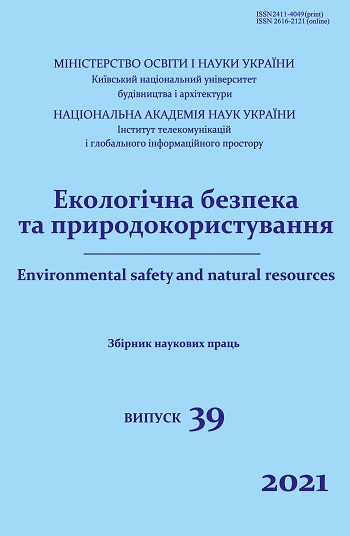Influence of global climate change on air pollution in urbanized areas and spread of COVID-19 morbidity
DOI:
https://doi.org/10.32347/2411-4049.2021.3.5-15Keywords:
global climate change, air pollution, COVID-19, urban areas, morbidityAbstract
The purpose of this paper is to confirm for the conditions of Ukraine the hypothesis of a number of foreign authors on the relationship between the presence of air pollution by aerosol particles in urban areas and the number of patients with COVID-19. On the example of the main large cities of Ukraine the analysis between temperature factors, dust pollution of the atmospheric phenomena and processes of distribution of morbidity of the population on COVID-19 is made. The linear dependences in the logical coordinates between nature are obtained due to the confirmation of the cases of morbidity and the index of aerosol pollution of the atmospheric air of urban areas by solid private particles PM2.5 (AQIPM2.5). The correlation coefficients of the obtained dependences are in the range of 0.65–0.91. These data suggest the possibility of unification of data for the country for different climatic zones to assess and predict the incidence of population depending on air pollution in urban areas and climatic conditions, and may be promising in the future to find ways to reduce the impact of aerosols in the air on the human body and the purpose of finer cleaning in production processes and air exchange technologies in modern buildings and structures. According to the authors, there is a need for further research on the impact of humidity and the impact of the percentage distribution of natural and anthropogenic aerosols in the air of urban areas. Such studies will further make more accurate predictions about the impact of air pollution on human health in the context of global climate change.
References
Conticini, E.,,Frediani, B., & Caro, D. (2020). Can atmospheric pollution be considered a co-factor in extremely high level of SARS-CoV-2 lethality in Northern Italy? Environmental Pollution, 261, June 2020, 114465. DOI: https://doi.org/10.1016/j.envpol.2020.114465.
Studies linking air pollution to the severity of COVID-19. Retrieved from: https://olik-gp.livejournal.com/73217.html.
Ciencewicki, J. et al. (2007). Air Pollution and Respiratory Viral Infection. Inhalation Toxicology, 19:14, 1135-1146. DOI: https://doi.org/10.1080/08958370701665434
Sipakov, R., Trofimovich, V., Voloshkina, O., & Bereznitskaya, Y. (2018). Impact of Weather Factors on the Speed of the Reaction of Formaldehyde Formation Above Motorway Overpasses. Environmental Problems, 3(2), 97-102.
Chugai, A.V., Guseva, K.D., & Kukui, D.V. (2012). Atmospheric air pollution in Odessa. Man and the environment. Problems of neoecology, 1-2, 20-26 [in Ukrainian].
Shevchenko, O.G., Kulbida, M.I., Snizhko, S.I., Shcherbukha, L.S., & Danilova, N.O. (2014). The level of air pollution in the city of Kiev with formaldehyde. Ukrainian Hydrometeorological Journal, 14, 2-22 [in Ukrainian].
Trofimovich, V.V., Voloshkina, O.S., Fandikova, M.M., Klimova, I.V., & Zhuravskaya, N.E. (2012). Atmospheric air monitoring. Problems of modeling and forecasting. Ecological safety and nature resources, 10, 102-120 [in Ukrainian].
Sipakov, R.V., Voloshkina, O.S., Bereznytska, Y.O., & Klimova, I.V. (2018). Risk assessment for public health from emissions from road transport in Kyiv. Environmental security and balanced resource use. Scientific and Technical Journal, 1(17), 14-20 [in Ukrainian]. DOI: https://doi.org/10.32557/ext-10-2018-1
Setti, L. et al. (2020). Evaluation of the potential relationship between Particulate Matter (PM) pollution and COVID-19 infection spread in Italy. Retrieved from: http://www.simaonlus.it/wpsima/wp-ontent/uploads/2020/03/COVID_19_position-paper_ENG.pdf
Sedlmaier, N. et al. (2009). Generation of avian influenza virus (AIV) contaminated fecal fine particulate matter (PM2.5): Genome and infectivity detection and calculation of immission. Veterinary Microbiology, 139(1-2). DOI: https://doi.org/10.1016/j.vetmic.2009.05.005
Despres, V.R. et al. (2012). Primary biological aerosol particles in the atmosphere: a review. Tellus B: Chemical and Physical Meteorology, 64(1), 15598. DOI: https://doi.org/10.3402/tellusb.v64i0.15598
Klimova, I., & Sipakov, R. (2019). Influence of meteorological factors on the secondary contaminationof atmospheric air by formaldehyde (on example of city of Kyiv). Scientific Letters of Academic Society of Michal Baludansky, Kosice, (Slovakia), 7(2/2019), 75-86. DOI: https://doi.org/10.32557/issn.2640-9631/2019-1
Coronavirus situation monitoring system. Retrieved from: https://covid19.rnbo.gov.ua/
Downloads
Published
How to Cite
Issue
Section
License
Copyright (c) 2021 Olena Voloshkina, Tetyana Shabliy, Volodymyr Trofimovich, Volodymyr Efimenko, Artem Goncharenko, Olena Zhukova

This work is licensed under a Creative Commons Attribution 4.0 International License.
The journal «Environmental safety and natural resources» works under Creative Commons Attribution 4.0 International (CC BY 4.0).
The licensing policy is compatible with the overwhelming majority of open access and archiving policies.

